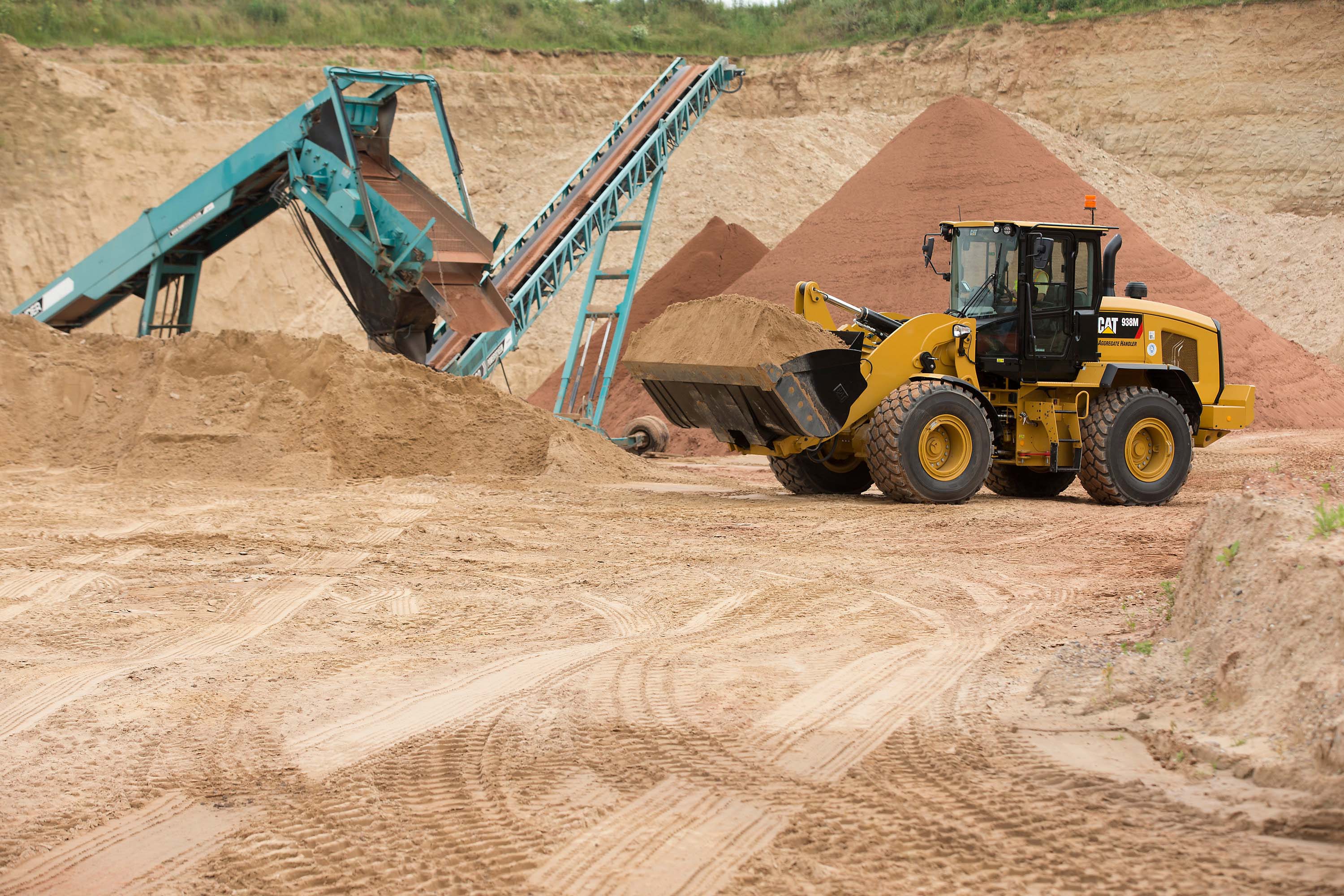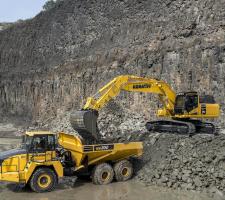
The processing of aggregates and rock material starts at the drilling and blasting or breaking stage, but such material has to be moved quickly to the processing plant, writes Patrick Smith.
Excavators are usually the equipment of choice to load material from the quarry face onto haul trucks to be taken to crushing and screening facilities, and are also used to carry the breakers and to remove loose material from a quarry face.
Wheeled loaders are also widely used to load haul trucks and can be used to load material directly into a crusher or move it around the quarry, while at some quarries conveyors are in operation to move material around.
Like all quarry equipment, hydraulic excavators, wheeled loaders or conveyors are built to withstand severe quarry conditions, with manufacturers constantly updating and improving models.
In Israel, three large, heavy-duty
The Hitachi ZX470LCH-5s and a ZX520LCH-5 join an existing fleet of construction machinery at a 170hectare site near Elifelet village, overlooking the Sea of Galilee.
The excavators are used to select and extract the stones from a depth of no more than 3m, after which each area is replenished to its former state. The materials, D rock (1-3tonnes) and C rock (3-6tonnes) are then determined by checking the weight, size and quality, before being transported to stockpiles for the ports.
The site opened in 2013 and the initial order for 200,000tonnes of rock was completed within eight months, but the AD Edan Hadash team is now geared up to supply a capacity of 300,000tonnes/year, with a total quantity of between 7-8 million tonnes to be delivered.
“We are very comfortable with the fact that CMD and Hitachi monitor the machines using Global e-Service. The whole service package gives me the peace of mind to concentrate on other important activities within the business,” says Dan Cohen, company owner.
Some 4,000km to the northeast is County Fife, Scotland, which is home to the
The loader is rehandling and stocking at Skene’s Soutra Mains Quarry, near Pathhead, County Midlothian, 18km south of Scotland’s capital city, Edinburgh. To gain access to the raw material the overburden is removed by the company’s fleet of excavators, wheeled loaders and haulers. This material is used to landscape the quarry or stored for later site restoration purposes.
The EC480D excavator at the Lomond Quarry has been specified with a 7m boom and 3.25m dipper arm, both heavy-duty variants, and it also has added belly plates and a cab-protecting falling object guard. A refurbished rock bucket owned by Skene is fitted to the excavator, which is feeding blasted dolerite rock into a mobile primary crusher followed by processing through a secondary crusher and screening to produce different stone sizes.
Innovative features introduced with the K-Series carry over to the new M-Series family. With the M-Series introduction, the nomenclature for the smallest model in the family changes from 924 to 926, reflecting the increased capabilities of the new model, compared with those of the 924H and 924Hz. All three new models have increased engine power and higher tip loads for improved performance.
A new Cat C7.1 ACERT engine powers the loaders, and Caterpillar says it has a clean emissions module designed to require no operator intervention and causing no disruption of work cycles. The module uses a fit-for-life diesel particulate filter (DPF) and a selective catalytic reduction (SCR) system, which requires only the addition of diesel exhaust fluid. Regeneration of the DPF occurs passively at a low temperature. Cat Product Link, which is said to help lower owning and operating costs, and which offers daily operations support and information for business decisions, is standard.
Other major manufacturers have also unveiled new models including
“The new excavators offer the strength and productivity needed for heavy-duty work such as large-scale earthmoving, moving rock, pulling down buildings, secondary breaking, loading haulers and pipeline projects found on quarrying and mining, highway, aggregate, demolition, utility and general construction projects,” says Doosan.
The excavators are powered by
Doosan’s new 30tonne DX300LC-5 Stage IV-compliant crawler excavator has its operating weight increased by 900kg, and this says the company, results in increases in lifting capacities of 1% over the front and 5% over the side, while the company’s new 36tonne DX340LC-5 and 40tonne DX380LC-5 Stage IV-compliant crawler excavators have also seen operating weights increased by 1,300kg and 1,000kg respectively.
“This latest Komatsu technology is a revolution in how hydraulic excavators will be used in the coming years” says Mal McCoy, product manager for hydraulic excavators and intelligent machine control products.
“The ability of the PC210LCi-10 to achieve and maintain grade with minimum effort from the operator is awesome.”
With an operating weight of 22.62-23.48tonnes, depending on configuration, the excavator is fitted with Komatsu’s KOMTRAX technology that sends data such as operating hours, fuel consumption, location, cautions and maintenance alerts to the web application for analysis. It is also said to increase machine availability; reduce the risk of machine theft; allow for remote diagnosis by the distributor, and provides a wealth of other information to “drive business efficiency and productivity.”
Komatsu Europe International says its new PC490LC-11 hydraulic excavator, with operating weights between 46,470kg-48,860kg, sees an EU Stage IV Komatsu engine with a net 270kW at 1,900rpm offering up to 11% improved fuel efficiency along with an upgraded cab design and enhanced safety and serviceability.
The new PC240LC-11 has operating weights between 24,700kg-26,200kg, and its EU Stage IV Komatsu engine has a net 141kW at 2,000rpm; up to 6% improved fuel efficiency; an upgraded cab design; and enhanced serviceability.
For Generation 10 (20tonnes- 35tonnes), Kobelco says fuel efficiency improvements have been realised through regenerative technology.
“Generation 10, for example SK210LC-10, with Stage 4 engine configuration delivers greater performance and efficiency in its working environment when compared to the previous Generation 9 equivalent,” says Kobelco.
“In H-mode (heavy work), work volume increases by 6.7% for the same level of fuel consumption. In S (normal work) and Eco modes fuel consumption is reduced by an impressive 6.1%,” says Peter Stuijt, KCME product marketing manager.
JCB develops remote-controlled excavator
Combining a JCB JS190 upper structure with a JS220LC undercarriage and rubber track pads, the result is a machine that can deploy a 4tonne multi-processor attachment without exceeding a gross weight of 25tonnes.
Development of the “ground-breaking machine” required close cooperation between Coleman Engineering Services; dealer Gunn JCB and JCB Heavy Products in Uttoxeter, County Staffordshire, England. The new excavator is working on the redevelopment of Birmingham New Street railway station, removing the existing reinforced concrete floors to create a void beneath the new atrium roof.
The current phase sees the removal of 6,000tonnes of mass reinforced concrete during 2014-2015, with some beams weighing as much as 80-90tonnes.


















